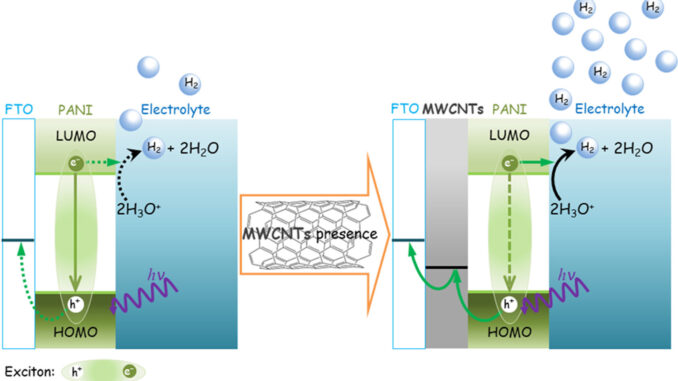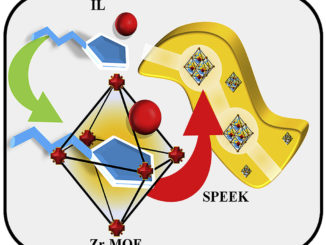
In situ polymerised polyaniline films over multi-walled carbon nanotubes coatings for enhanced photoelectrochemical performance
Abstract: Polyaniline (PANI), which is a π-conjugated polymer, has stood out as a promising candidate for dihydrogen generation in photoelectrochemical (PEC) cells owing to its suitable optoelectronic properties and excellent stability. Nevertheless, the PEC performance of this material is still far from adequate for technological applications. Herein, we have focused on improving the PEC performance of PANI films by combining this polymer with multi-walled carbon nanotubes (MWCNTs) layers. Specifically, we have assessed the PEC activity of the in situ polymerised PANI films onto FTO substrates coated with different amounts of MWCTNs for the hydrogen evolution reaction (HER). The FTO/MWCNTs/PANI films with the optimum deposited amount of MWCNTs (i.e., 30 μL) featured a 2.4-fold increase of the cathodic photocurrent density response for the HER compared to that of FTO/PANI film. Moreover, the FTO/(30 μL)-MWCNTs/PANI films exhibited good PEC stability, as observed by the relatively low cathodic photocurrent density decay of up to 7% during 3720 s of stability test. Based on joint analyses of physical and PEC characterisation, the improved PEC performance for the FTO/(30 μL)-MWCNTs/PANI films were assigned to the combined contribution of the following factors: (i) enhancement of light absorption; (ii) possible improvement of excitons dissociation; (iii) minimisation of the electron-hole recombination process; and (iv) facilitation of electrons transfer at the PANI|electrolyte interface for the HER. The enhancement of PEC performance achieved in this work for the fully organic photocathode composed of MWCNTs/PANI paves the way to invest in additional modifications seeking to further improve the dissociation of excitons and the interfacial transfer of charge carriers for the light-driven HER.
Author(s): Alessandra A. Correa, Moisés A. de Araújo, Lucia H. Mascaro, Luiz H.C. Mattoso, José M. Marconcini
Polymer
Published: 9 April 2024, Volume 298, 126869
DOI: https://doi.org/10.1016/j.polymer.2024.126869
CDMF
The CDMF, hosted at the Federal University of São Carlos (UFSCar), is one of the Research, Innovation and Dissemination Centers (RIDC) supported by the São Paulo State Research Support Foundation (Fapesp), and also receives investment from the National Council Scientific and Technological Development (CNPq), from the National Institute of Science and Technology of Materials in Nanotechnology (INCTMN).




